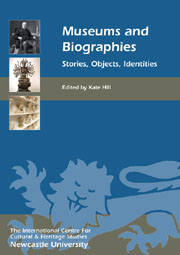Book contents
- Frontmatter
- Contents
- List of Illustrations
- Introduction: Museums and Biographies – Telling Stories about People, Things and Relationships
- INDIVIDUAL BIOGRAPHY AND MUSEUM HISTORY
- PROBLEMATISING INDIVIDUALS' BIOGRAPHIES
- INSTITUTIONAL BIOGRAPHIES
- OBJECT BIOGRAPHIES
- MUSEUMS AS BIOGRAPHY
- MUSEUMS AS AUTOBIOGRAPHY
- 19 Autobiographical Museums
- 20 Who is History? The Use of Autobiographical Accounts in History Museums
- 21 Community Biographies: Character, Rationale and Significance
- Endpiece: The Homunculus and the Pantograph, or Narcissus at the Met
- List of Contributors
- Index
20 - Who is History? The Use of Autobiographical Accounts in History Museums
from MUSEUMS AS AUTOBIOGRAPHY
Published online by Cambridge University Press: 05 February 2013
- Frontmatter
- Contents
- List of Illustrations
- Introduction: Museums and Biographies – Telling Stories about People, Things and Relationships
- INDIVIDUAL BIOGRAPHY AND MUSEUM HISTORY
- PROBLEMATISING INDIVIDUALS' BIOGRAPHIES
- INSTITUTIONAL BIOGRAPHIES
- OBJECT BIOGRAPHIES
- MUSEUMS AS BIOGRAPHY
- MUSEUMS AS AUTOBIOGRAPHY
- 19 Autobiographical Museums
- 20 Who is History? The Use of Autobiographical Accounts in History Museums
- 21 Community Biographies: Character, Rationale and Significance
- Endpiece: The Homunculus and the Pantograph, or Narcissus at the Met
- List of Contributors
- Index
Summary
INTRODUCTION: WE ARE HISTORY!
From October 2007 until May 2008, on the occasion of the celebration of the 50th anniversary of the Rome Treaties, the Brussels-based non-profit organisation Museum of Europe showed the exhibition ‘It's our history!’. ‘It's our history!’, which was originally meant as the opening exhibition of a bigger museum of European history, was on display in a slightly altered form under the title ‘Europa – To nasza historia’ in Wrocław during the summer of 2009. Its subject was the history of European integration from 1945 to 2007 and, as the title – It's our history! – indicates, it was the Museum of Europe's aim to show this history as a history from below; as a history of Europe's citizens.
The exhibition started in the lobby with an introductory ‘manifesto’ stating that ‘the History, with a capital H, of European construction is inextricable from our own personal history, that of each European citizen. It is not the reserve of those who govern us.’ This concern for a history of the people found its materialisation in the use of ‘27 ordinary citizens from the 27 countries of the European Union’ (Tempora 2009, 23) who told episodes from their life-stories in video stations distributed throughout the exhibition. Here, the Germans Inge and Klaus Stürmer, for example, related their flight from the GDR in 1962; the Belgian Rita Jeusette told of her participation in the 1966 strike at the National Weapons' factory in Herstal, where women workers fought for equal pay; and the Hungarian Gyula Csics recollected his experience of the Hungarian uprising that he witnessed in 1956 as a 12-year-old.
- Type
- Chapter
- Information
- Museums and BiographiesStories, Objects, Identities, pp. 295 - 308Publisher: Boydell & BrewerPrint publication year: 2012



